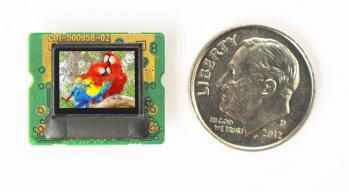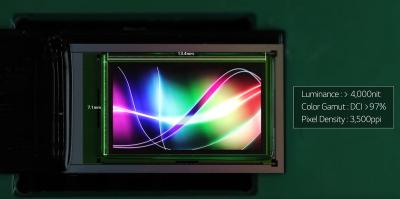OLED is a next-generation display technology that is replacing LCD displays in several markets, such as small displays for mobile applications, TVs and microdisplays. OLEDs are made from thin films of organic light emitting materials that emit light when electricity is applied. OLEDs have a much simpler structure compared to LCDs and have several advantages over the incumbent technology.

OLED microdisplays
OLED microdisplays are considered to be the current state-of-the-art near-eye display technology. OLEDs offer many advantages over competing technologies:
- No backlight - a direct emissive display with high contrast and a wide color gamut
- Fast refresh rate
- Low power consumption (this depends on the image shown)
- Wide operation temperature range
OLEDs do suffer from lower lifetime, limited market capacity, high price. Many believe that microLEDs will offer the ultimate solution for microdisplays, with their inherent high brightness and efficiency, but these displays are not commercial yet.
The OLED Microdisplay industry
Several companies in the US, Europe and Asia are producing OLED microdisplays - including eMagin (acquired by Samsung in 2023), Sony, OLiGHTEK, Kopin, BOE and SeeYa. In addition, Samsung and LG are both gearing up towards OLED microdisplay production.

If you're interested in adopting OLED microdisplays in your device, we'll be happy to help, you can browse available display in our OLED marketplace. Be sure to send us a mail and together we can find the best display for your project.
Learn more about the OLED Microdisplays industry and market
Are you looking for more in-depth information on the OLED Microdisplay industry? Check out our OLED Toolbox, which provides a complete set of information products and tools for OLED professionals. The Toolbox provides an unprecedented depth of OLED content, data, analysis and insights, written and compiled by the industry's leading portal, OLED-Info.com.
The OLED Toolbox includes details on all OLED microdisplay developers and producers, a list of all current and planned fabs, a list of all microdisplays on the market, many company brochures and roadmaps, and more.
The US sends a Russian citizen to 3 years in prison for smuggling OLED microdisplays to Russia
In September 2023, the New York State Attorney arrested a Russian citizen called Maxim Marchenko, and two other co-conspirators, accusing them of buying $1.6 million worth of military-grade OLED microdisplays and smuggling these to Russia. The US export control laws forbid the sale of such components to Russian companies.

Earlier this week, Maxim Marchenko was sentenced to three years in prison followed by three years of supervised release for his role in procuring the dual-use, military grade OLED micro-displays.
Sidtek starts trial production at its 12-inch OLED microdisplay fab in Wuhu
Sidtek announced that it is starting trial production of OLED microdisplays at its upcoming 12-inch fab in Wuhu, Anhui Province, China. The company is on track to initiate mass production before the end of 2024.
Sidtek is currently producing its OLED microdisplays on a 8-inch production line, also in Wuhu. The first phase of its new 12-inch fab will have a monthly capacity of 6,000 substrates, and the company is planning an expansion to 18,000 substrate (which will be ready in 2027). The total investment in the 12-inch fab (including the 2nd stage and another, third phase) is estimated at 6 billion Yuan (around $840 million USD).
Apple reportedly reaches out to Samsung and LG regarding the supply of OLED microdisplays
According to a report from Korea, Apple has sent an RFI for both Samsung Display and LG Display, seeking more information about the two companies capabilities regarding the production of OLED microdisplays. It is speculated that Apple is seeking to change its OLED supplier in a future, lower-cost VR headset.
Apple specifically mentions a white OLED with color filters architectures (i.e. not a direct-patterned device), a panel size of 2 to 2.1 inch and a display density of around 1,700 PPI (which is rather low, Sony's 4K microdisplays used in the Apple Vision Pro for example offer a density of almost 3,400 PPI).
Kopin's OLED microdisplays to power the US Army's Stinger replacement interceptor system
Kopin announced that it has been chosen to develop a high-resolution eyepiece assembly, based on its OLED microdisplays, for use in the new Commanders Launch Assembly (CLA), used in the US Army’s Next Generation-Short Range Interceptor (NG-SRI) system.
The NG-SRI system will replace the currently-used Stinger missiles, and will be faster, will be able to overcome energy jamming - and it will be able to hit challenging targets like drones, with greater precision and accuracy. Once the development is done and production begins, Kopin estimates it will generated $5-10 million per year for sevearl years.
Lumicore Showcases High-End Digital-Driven Silicon OLED Microdisplays
Lumicore showcased its groundbreaking 1.32-inch OLED microdisplay at SID Displayweek in San Jose, a digital-driven silicon microdisplay that represents a substantial advancement in the field of micro-OLED displays. This innovation promises improvements in display quality, power consumption, and production yield, making it highly suitable for AR and VR/MR applications.
Lumicore's expertise lies in its digital driving technology, which precisely controls pixel brightness in Micro-OLEDs through Pulse Width Modulation (PWM). This approach maintains a constant voltage across the OLED, preventing substantial fluctuations in current and brightness due to minor voltage changes.Compared to traditional analog driving, digital driving effectively mitigates noise interference, offering higher grayscale modulation accuracy, faster screen refresh rates, lower circuit power consumption, and reduced manufacturing costs, thereby revolutionizing the conventional technology.
SEL demonstrates a 15,000 nits direct-emission tandem OLED microdisplay
Japan's Semiconductor Energy Laboratory (SEL) demonstrated its latest OLED microdisplay technology at Displayweek 2024. The 1.5" 3840x2880 (3207 PPI) display achieves a brightness of 15,000 by using a tandem architecture and a direct-emission design. The OLED deposition was performed using photo-lithography.
This is an impressive display, with very high brightness. It surpasses LGD's 10,000 nits microdisplay also shown at Displayweek, which uses a white-OLED with color filter design, and a microlens array. It matches eMagin's 15,000 nits microdisplay, demonstrated back in 2023 - which is a single stack device.
BOE shows new OLED displays at SID Displayweek 2024
BOE had a large demonstration at Displayweek 2024, showing several display technologies and many new panels and prototypes.
First up we have a slidable OLED display, one of the largest we've seen, at 31.6". The display offers a resolution of 5944x1672, a sliding distance of just over 260 mm (BOE says its the world's longest) and a sliding radius of 5 mm.
LG Display shows its latest OLED displays at Displayweek 2024
LG Display demonstrated its latest OLED display prototypes and commercial panels at Displayweek 2024. The company showed flexible panels, automotive displays, transparent OLED, gaming monitors, a 10k nit microdisplay and more.
So first up, LG Display shows its automotive Advanced-Thin-OLED (ATO) displays, which are produced on glass substrates and use a tandem structure. These OLEDs are lower in cost compared to LGD's flexible automotive p-OLED panels, but still enable low-weight and thin profile, and the excellent image quality of an OLED display. The smaller display was a 12.3" 2400x900 (209 PPI) 1,000 nits panel, while the other panel was larger at 17" 1920x2560 (188 PPI).
Samsung shows its latest OLED and QD-EL displays at Displayweek 2024
Samsung Display had a rather large booth at Displayweek 2024, showing its latest OLED displays and technologies. Samsung showed several displays - including foldable smartphone panels, laptop and tablet displays, two QD-OLED displays, its 9.4" round automotive AMOLED, and more.
One interesting display was a panel that combines a foldable and a rollable display, that can open up to an impressively large display. Samsung brands it as a Flex Note Extendable Display.
LG Display developed a 10,000 nits OLED microdisplay
LG Display developed a new OLED microdisplay (OLEDoS) that achieves a brightness of 10,000 nits. This development is presented at SID DisplayWeek 2024.
To achieve this high brightness, LG Display's research team used newly-developed high performance OLED materials, and also used a micro lens array (MLA) to expand the light output from the device.
Pagination
- Page 1
- Next page





